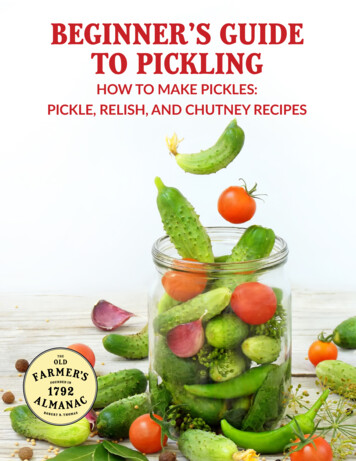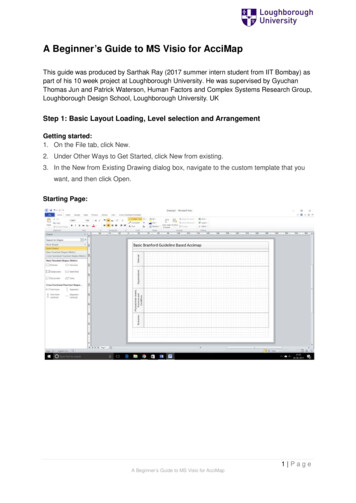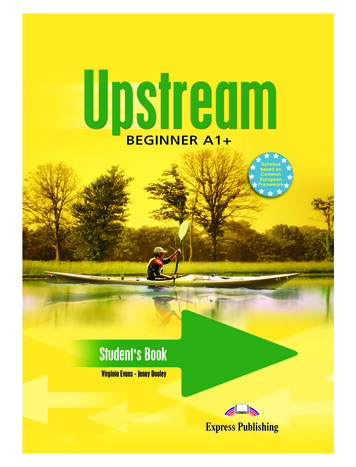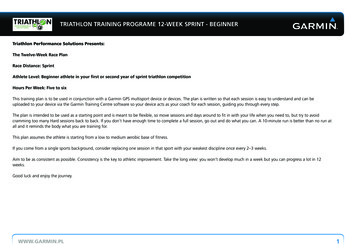
Transcription
BEGINNER’S GUIDETO PICKLINGHOW TO MAKE PICKLES:PICKLE, RELISH, AND CHUTNEY RECIPES1THE OLD FARMER’S ALMANAC
TABLE OF CONTENTSBEGINNER’S GUIDE TO PICKLINGHOW TO MAKE PICKLES: PICKLE, RELISH, AND CHUTNEY RECIPESPREPARING TO PICKLE.3PICKLE PROBLEMS.5PICKLED VEGETABLES.5PICKLED FRUIT.11RELISHES.12CHUTNEYS.16ALMANAC GARDEN PLANNER.181THE OLD FARMER’S ALMANAC
LEARN MORE
PICKLES, RELISHES, AND CHUTNEYSPickling is a great way to store excess vegetables. But pickling isn’t just for cucumbers. You can pickle peppers,onions, tomatoes, carrots, watermelon, peaches—lots of different vegetables and fruit can be pickled! Give theserecipes a try and enjoy the garden’s bounty for months to come.PREPARING TO PICKLEPickles should be made from young, fresh, sound vegetables and fruit, quality vinegar, and fresh, wholespices and herbs. Satisfactory pickled products are the result of quality ingredients, proper proportions, andcarefully followed recipes.When choosing fruit and vegetables for pickling, select those that are nearly the same size so that the picklingrate will be uniform.HOW TO CLEAN PRODUCEFruit and vegetables to be pickled should be washed thoroughly with a vegetable brush under running water.Soil or any soft spots left on the vegetables may contain bacteria, which can cause the pickles to spoil. Cucumbers for pickling whole may have about a half-inch of the stem left on; be sure to remove the blossomends of the cucumbers, as they contain an enzyme that can cause softening of the cucumbers during fermentation.WHICH SALT TO USESalt for pickling brines should be canning or pickling salt—a pure, granulated or rock salt that has no iodineadded. The iodine in table salt will darken pickles. Plain table salt may be used, but it contains anti-cakingagents, which will cloud the brine.DIFFERENCES AMONG VINEGARSVinegar must have an acidity of 4 to 6 percent for pickling purposes. (The strength of vinegar is usuallyshown on the label.) Wine vinegars do not do well for pickling because they will develop a mother, a gathering of yeast and other bacterial organisms, during fermentation. Cider vinegar will give a fuller, more richlyflavored pickle but will also add some color to the pickle. If a lighter color product is desired, as with pickledpears or onions, white distilled vinegar should be used. Cider vinegar imparts a mellower taste and whitevinegar a sharper taste, but both serve equally well for pickling.Use the exact proportions of vinegar called for in your recipe; the vinegar is important to the keeping qualityof the pickle. If the syrup or brine tastes too sharp, do not decrease the amount of the vinegar, but insteadadd more sweetener until the taste is right.WHAT KIND OF JARS?Use only jars that are specifically designed for home canning, such as mason or Ball jars. Most canning jarsare sold with two -piece lids—a round metal screw band and a removable flat metal lid that has a rubber-typesealing compound around the outer edge. The screw band can be reused if it is cleaned well and does notrust. To ensure a tight seal, do not reuse the flat metal lids.3THE OLD FARMER’S ALMANAC
HOW TO STERILIZE JARSBefore every use, thoroughly wash empty jars and lids in hot water and detergent and rinse well. To sterilizeempty jars just before filling, put them right side up in a stockpot. Fill the pot and jars with water to 1 inchabove the tops of the jars. Boil for 10 to 15 minutes. Turn off the heat and keep the jars in the hot water untilready to use. Using tongs, take out one at a time as needed and remove water.To sterilize screw bands, place them in a small saucepan. Add enough water to cover and bring to a simmer(not a rolling boil) over medium heat. Keep the bands hot until ready to use. Keep any flat metal lids at roomtemperature.WHAT IS HEADSPACE AND HOW MUCH IS ENOUGH?Headspace is the amount of air space between the top of the food or liquid put into a jar and the inside of thejar lid. For a strong seal, fill each jar to the proper headspace level. In general, allow: 1/4-inch of headspace for jams, jellies, juices, pickles, and relishes 1/2-inch of headspace for acidic foods such as tomatoes and fruit 1 inch of headspace for low-acid foods such as meats and most vegetables (if tomatoes are mixed withmeats or other vegetables, consider the mixture low-acid)IS PROCESSING NECESSARY?Yes, pickles and relishes need to be processed. This heat treatment will destroy organisms that might causespoilage and inactivate the enzymes that could affect flavor, color, and texture during storage. Process products for the length of time specified in the recipe. If unsure about the length of time, process the jars for atleast 10 minutes.PROCESSING: THE BOILING WATER BATHMETHODIn this procedure, jars of food are completelycovered with boiling water and heated for aspecific amount of time. Use this method tosafely can tomatoes, fruit, jams, jellies, andpickles. Start counting the processing timewhen the water starts to boil.PROCESSING: THE PRESSURE CANNINGMETHODIn this procedure, jars of food are set in 2 to3 inches of water in a pressure canner andcooked at a high temperature for a specificamount of time. (Follow the directions provided by the manufacturer of your pressure canner.) Use this method to safely can many foodswith a low acidic content and a pH of 4.6 andhigher, including meat, seafood, poultry, dairyproducts, and vegetables.HOW LONG WILL PROCESSED FOOD LAST?Food that is processed correctly and stored properly should be safe for up to 18 months. Once the food hasbeen opened and put into the refrigerator, treat it as you would any other fresh food.Place any jars that do not seal properly in the refrigerator and eat within 2 months.4THE OLD FARMER’S ALMANAC
PICKLE PROBLEMSWhat went wrong? Peruse this list for possible explanations for inadequate pickling results.Soft or slippery pickles: too little salt or acid in brine; scum in brining process not removed regularly; cucumbers not covered with brine; too warm a storage temperature; insufficient processing; blossom ends notremoved from cucumbers.Hollow pickles: poorly developed cucumbers; cucumbers left too long between harvest and pickling; improper brine strength.Shriveled pickles: allowing too much time between gathering and pickling; pickling solution too sweet or toostrong in vinegar; brine too salty at beginning of curing; overcooking or overprocessing of pickle.Dark pickles: use of ground spices or too much spice; use of iodized salt; minerals in water, especially iron;use of iron utensils; overcooking.Poorly colored or faded pickles: poor-quality cucumbers; sunburned or overmature fruit.PICKLED VEGETABLESSPICY BREAD AND BUTTER PICKLESBread and Butter Pickles got their name from Omar and Cara Fanning in the 1920s. The Fannings made aliving by growing vegetables, mainly cucumbers. During a particularly poor growing season, Mr. Fanning decided to use the meager cucumbers he harvested to make an old family recipe for sweet and sour pickle chips. Mrs.Fanning was able to trade these pickles for things she needed at the local grocer, including bread and butter.5 pounds cucumbers, sliced8 small onions, shredded2 green peppers, shredded1/2 cup pickling salt5 cups white vinegar5 cups sugar2 whole cloves2 tablespoons mustard seed1-1/2 teaspoons turmeric1 teaspoon celery seedMix cucumbers, onions, peppers, and salt in a bowl. Cover with ice cubes and let stand for 3 hours. Drain.Bring vinegar, sugar, cloves, mustard seeds, turmeric, and celery seeds to a boil, then immediately removefrom heat. Pack vegetables into sterilized jars, leaving 1/4-inch of headspace. Pour the hot liquid over vegetables until covered. Seal and process for 10 minutes; start counting the processing time when the water startsto boil.Makes 4 to 5 quarts.5THE OLD FARMER’S ALMANAC
DILL PICKLES4 pounds small cucumbers16 cloves garlic, peeled and blanched8 fresh sprigs of dill24 black peppercorns for each jar2 quarts white vinegar1/2 cup pickling saltSoak freshly picked cucumbers in a bowl of ice water overnight. Remove and dry cucumbers, then pack into8 sterilized jars. Into each jar add 2 cloves garlic, 1 sprig dill, and 4 peppercorns. Bring 2 quarts of water to aboil. Add vinegar and salt and boil for 5 minutes. Pour hot liquid over cucumbers, leaving 1/4-inch of headspace. Seal and process for 10 minutes; start counting the processing time when the water starts to boil.Makes 8 pints.GROW THE BEST: CUCUMBERSWondering what variety of cucumbers to grow to make pickles? Find some suggestions on our cucumberpage.SWEET REFRIGERATOR PICKLES“Refrigerator” pickles need no processing. They can be eaten right away, but the flavor is better after about aweek6 to 8 cucumbers, sliced2 bell peppers, sliced3 hot peppers, sliced2 onions, sliced1 tablespoon pickling salt2 cups apple-cider vinegar2 cups sugar2 teaspoons celery seed2 teaspoons mustard seedPlace cucumbers, peppers, and onions in a large bowl. Sprinkle with salt and let set for 1 hour. Drain. Stirtogether the vinegar, sugar, celery seeds, and mustard seeds until sugar is dissolved. Pour over cucumbers.Store in a covered glass or plastic container in the refrigerator.Makes about 4 quarts.SWEET AND SOUR WAX BEANS“Wax” beans are yellow snap or string beans. They are similar in taste to green beans. Serve this nearly forgottendelicacy with pork instead of applesauce.2 pounds wax beans, cut diagonally into 1-inch piecessalt, to taste1 cup white vinegar1/2 cup sugar1 teaspoon celery seed1 teaspoon dried summer savory or 1 tablespoon chopped fresh summer savorypinch of ground gingersmall bay leaves6THE OLD FARMER’S ALMANAC
Cover beans with water, add salt to taste, and cook until just barely tender. Drain the liquid into another pot,then add to it the vinegar, sugar, celery seeds, summer savory, and ginger. Add more water if needed so thatthere will be enough liquid to fill the jars. Bring liquid to a boil, add beans, and return to a boil. Pack 4 sterilized jars with vegetables and hot liquid, leaving 1/4-inch of headspace. Add a bay leaf to each jar. Seal andprocess for 5 minutes; start counting the processing time when the water starts to boil.Makes about 4 pints.DILLY BEANSThis pickle name refers to the herb in this recipe: dill.2 pounds whole green beans, trimmed1 teaspoon cayenne pepper4 cloves garlic, blanched4 heads dill2-1/2 cups white vinegar1/4 cup pickling saltPack beans lengthwise into 4 sterilized jars, leaving 1/4-inch of headspace. To each jar, add 1/4 teaspoon cayenne, 1 garlic clove, and 1 head dill. Bring vinegar, salt, and 2-1/2 cups of water to a boil. Pour hot liquid overthe beans, leaving 1/2-inch of headspace. Seal and process for 5 minutes; start counting the processing timewhen the water starts to boil.Makes 4 pints.GROW THE BEST: BEANSIf you don’t know beans about beans, we can help. Check out our beans page.PICKLED BEETS4 beets2 cups white vinegar2 cups sugar1 whole clove1 cinnamon stick (1-inch)Cook beets until tender, remove skins, and slicelengthwise. In a separate pan, bring vinegar, sugar, clove, and cinnamon stick to a boil. Place beets in a jar orbowl and cover with hot liquid. The beets will be ready to eat in 3 days. Keep refrigerated.CARROT PICKLES4 to 6 carrots, peeled and sliced1 cup white vinegar1/2 cup sugar1/2 tablespoon mixed pickling spicePack carrots into a pint jar. Bring vinegar, sugar, pickling spice, and 1/4 cup of water to a boil in a glass orenamel saucepan for 10 minutes. Pour hot liquid over the carrots, leaving 1/4-inch of headspace. Seal andprocess for 10 minutes; start counting the processing time when the water starts to boil.Makes about 1 pint.7THE OLD FARMER’S ALMANAC
GROW THE BEST: CARROTSHaving trouble growing carrots? It might be your soil. Find out more on our carrots page.PICKLED ONIONSStore these pickled onions for at least 2 weeks before sampling them.milk (for boiling)water (for boiling)2 quarts small white onions, peeled2 quarts white vinegar12 whole cloves1/2 tablespoon pickling salt1 teaspoon alum1/2 teaspoon maceBoil onions for 10 minutes in equal amounts of milk and water. Put vinegar in a glass dish or porcelain pan.Add cloves, salt, alum, and mace. Scald (heat to almost boiling) well. Drain onions and pack into sterilizedjars. Pour hot liquid over onions, leaving 1/4-inch of headspace. Seal and process for 5 minutes; start counting the processing time when the water starts to boil.Makes 4 pints.PICKLED PEPPERS2-1/2 cups white vinegar1/2 cup sugar6 red bell peppers, sliced6 green bell peppers, sliced6 yellow bell peppers, sliced2 teaspoons pickling salt2 teaspoons mustard seed2 teaspoons whole allspiceBring vinegar, sugar, and 2-1/2 cups of water to a boil. Add peppers and heat through. Remove peppers fromliquid with a slotted spoon and pack into sterilized jars. To each jar, add 1/2 teaspoon salt, 1/2 teaspoon mustard seeds, and 1/2 teaspoon whole allspice. Pour hot liquid over peppers, leaving 1/4-inch of headspace. Sealand process for 5 minutes; start counting the processing time when the water starts to boil.Makes 4 pints.GROW THE BEST: PEPPERSDid you know that red and yellow bell peppers are simply green bell peppers that were left to mature on theplant? Learn more on our bell peppers page.8THE OLD FARMER’S ALMANAC
GREEN TOMATO PICKLESThis is a perfect way to save end-of-season tomatoes.5 pounds green tomatoes1/2 cup pickling salt6 onions, sliced3 red bell peppers1/2 cup sugar1/2 tablespoon ground allspice1/2 tablespoon ground cinnamon1/2 tablespoon ground mustard1/2 teaspoon ground clovesapple-cider vinegarSlice tomatoes, sprinkle with the salt, and leave overnight. In the morning, drain off the liquid. Combine tomatoes, onions, peppers, sugar, and spices in a large pot. Cover with cider vinegar and bring to a boil. Cookuntil tender. Pour into sterilized jars, leaving 1/2-inch of headspace. Seal and process for 10 minutes; startcounting the processing time when the water starts to boil.Makes about 3 quarts.GROW THE BEST: TOMATOESAre you growing determinate or indeterminate tomatoes? Find more information about both types on ourtomato tips page.MUSTARD PICKLESThis garden variety tastes great and looks beautiful in clear glass jars.2 cups pickling salt1 quart sliced cucumbers2 quarts sliced green tomatoes1 quart small button onions1 head cauliflower, broken into small pieces4 green bell peppers, sliced4 red bell peppers, sliced1 bunch celery, finely chopped1-1/2 cups brown sugar1/2 cup all-purpose flour4 tablespoons ground mustard1 teaspoon turmeric2 quarts white vinegar2 sticks cinnamonseveral whole cloves, to tasteMake a brine by combining 4 quarts of water with the salt. Bring to a boil, add the vegetables, then removefrom heat. Let sit overnight. Heat vegetables again in brine, then drain. Mix brown sugar, flour, mustard, andturmeric with enough cold water to make a smooth paste. Heat vinegar, add flour mixture, and cook, stirringoften, until smooth. Add vegetables, cinnamon, and cloves. Allow to scald (heat to almost boiling) thoroughly. Pour into sterilized jars, leaving 1/4-inch of headspace. Seal and process for 10 minutes; start counting theprocessing time when the water starts to boil.Makes 6 quarts.9THE OLD FARMER’S ALMANAC
ZUCCHINI PICKLESNever say “No!” to zucchini—pickle it!2 quarts thinly sliced, unpeeled zucchini2 onions, thinly sliced1/4 cup pickling salt2 cups white vinegar2 cups sugar2 teaspoons mustard seed1 teaspoon celery seed1 teaspoon turmericCombine zucchini and onions, sprinkle with the salt, cover with cold water, and let stand for 2 hours. Drain,rinse with fresh water, then drain again. Bring vinegar, sugar, mustard seeds, celery seeds, and turmeric to aboil and cook for 2 minutes. Add vegetables, remove from heat, and let stand for 2 hours. Bring back to a boiland cook for 5 minutes more. Pour into sterilized jars, leaving 1/4-inch of headspace. Seal and process for 10minutes; start counting the processing time when the water starts to boil.Makes 4 pints.GROW THE BEST: ZUCCHINIWhat is the main difference between summer squash and winter squash? Find out on our zucchini page.DILL CROCKThe old general store’s pickle barrel finds a home version in the dill crock, a savory brine in a large stoneware orearthenware crock that turns common garden vegetables into tangy, soul-satisfying pickles. The crock can workright in the kitchen from July through September.Stoneware crocks range in size from as small as 1 quart to as large as 20 gallons. The 5-gallon size does not takeup much space and is not only adequate for pickling but also not too heavy to move when full. In some areas,crocks may be hard to come by; practical substitutes, although not as traditional, are large glass crocks, widemouth gallon jugs, and enameled preserving kettles. Here’s how to make your own dill crock.Make a brine in the crock using the proportions of 1 gallon water, 1 gallon apple-cider vinegar, and 1 cuppickling salt. If you like their flavor, toss in a few garlic cloves. Pack in clean, fresh vegetables alternately withfresh dill weed, using heads, stems, and leaves. Whole tiny fingerling cucumbers and larger ones cut intochunks will swim deliciously in the brine, as will any other firm-flesh vegetables, such as onions, peppers,and string beans. Try tossing in raw baby carrots, young peas in the pod, and cauliflower florets. Since thecrock is an ongoing process, you will have pickled vegetables in varying stages, from the mild, barely flavoredones to the zesty, full-flavor ones. Let your taste judge when they are ready. A few grape leaves or a sprig ofcherry leaves added to the brine will help to give a firmer pickle.Since this is a long-brining process, be sure to check the crock each day and skim off any scum on the surface. To keep the vegetables below the brine, weigh down a dinner plate that covers the brine surface with awater-filled jar or freshly scrubbed rocks.If you would like to preserve the last pickles left at the end of the garden season, let them work in the crock2 to 3 weeks, then remove them from the brine and pack them into hot, sterilized jars. Strain and heat thebrine. Fill the jars, leaving 1/2-inch of headspace, seal, and process for 10 minutes.10THE OLD FARMER’S ALMANAC
PICKLED FRUITSWEET PICKLED PEACHESLet the peaches stand for a few weeks before eating.8 to 10 small, firm, ripe peacheswhole cloves2 cups white vinegar2 cups sugar2 cinnamon sticks (3-inch)Scald the peaches, place in an ice-water bath, and remove skins. Leave whole (do not stone) and stick eachwith 3 cloves. Combine vinegar, sugar, 6 cloves, cinnamon sticks, and 1 cup of water in an enamel pot andbring to a boil. Cover and boil for 5 minutes. Add peaches, a few at a time, and continue boiling until peachesare soft. Spoon peaches into sterilized jars and pour hot liquid over peaches, leaving 1/2-inch of headspace.Seal and process for 20 minutes; start counting the processing time when the water starts to boil.Makes about 3 pints.SWEET PICKLED PEARS1 pint apple-cider vinegar4-1/2 cups brown sugar4 cinnamon sticks (4-inch)whole cloves4 quarts pears, peeled, halved, and seededCombine vinegar, brown sugar, and cinnamon sticks in an enamel pot and bring to a boil. Boil for 20 minutes. Stick 2 cloves into each pear half and cook pears in the liquid until soft. Spoon pears into sterilized jars.Strain the liquid and pour it over pears, leaving 1/2-inch of headspace. Seal and process for 20 minutes; startcounting the processing time when the water starts to boil.Makes about 4 quarts.GROW THE BEST: PEARSGrowing pears is as easy as (if not easier than) growing apples. Learn how on our pear page.WATERMELON PICKLESIf you’ve never had pickled watermelon, you’ve got to try this. It’s proof that you can indeed eat the whole thing.rind from half of a large watermelon6 cups sugar1 pint apple-cider vinegar1 tablespoon whole cloves1 tablespoon whole allspice1 cinnamon stick, brokenSlice watermelon rind into 1-inch strips and peel off the green skin. Cut rind into 1-inch chunks. Cover withcold water and boil for 20 minutes. Drain. In a pot, combine sugar and vinegar. Tie cloves, allspice, and cinnamon stick in a cheesecloth bag and add to sugar and vinegar. Bring mixture to a boil and pour over watermelon rind. Cover and allow to stand overnight.11THE OLD FARMER’S ALMANAC
Drain rind, but reserve liquid and spices and bring them to a boil again; pour over rind and let stand overnight a second time.Boil rind and liquid together until rind is transparent and liquid is the consistency of honey. Place rind insterilized jars and pour hot liquid over rind, leaving 1/2-inch of headspace. Seal and process for 5 minutes;start counting the processing time when the water starts to boil.Makes about 5 pints.GROW THE BEST: WATERMELONFind out how to tell if a watermelon is ripe by going to our watermelon page.RELISHESAPPLE PEPPER RELISH3 tart apples, peeled and cored3 sweet onions2 red bell peppers1/3 cup lemon juice1 tablespoon grated lemon zest1 cup sugar1 teaspoon pickling saltUse a food processor or grinder to shred the apples, onions, and peppers, then put into a pot. Add lemon juice and zest and bring to a boil. Add sugar and salt and bring back to a boil, stirring occasionally, for20 minutes. Pour into a sterilized jar, leaving 1/4-inch of headspace. Seal and process for 10 minutes; startcounting the processing time when the water starts to boil.Makes about 1 pint.WHAT’S THE APPLE OF YOUR PIE?Some apples are better than others for cooking and baking. Find out which varieties are best on our applebaking page.BEET RELISH4 pounds beets, cooked and peeled4 onions3 green bell peppers, seeded1 tablespoon whole cloves1-1/2 cups white vinegar1-1/2 cups sugar1 tablespoon pickling saltUse a food processor or grinder to shred the beets, onions, and peppers. Tie cloves in a cheesecloth bag. In apot, combine vinegar, sugar, salt, spice bag, and 1/4 cup of water. Bring to a boil and reduce heat. Add vegetables, cover, and simmer for 20 minutes, stirring several times. Remove cloves, then pour into sterilized jars,leaving 1/4-inch of headspace. Seal and process for 10 minutes; start counting the processing time when thewater starts to boil. Makes 6 pints.12THE OLD FARMER’S ALMANAC
GROW THE BEST: BEETSBeets come in a variety of colors from red to yellow to white. Find out more on our beets page.CABBAGE RELISH2 cups white vinegar3/4 cup sugar1/4 cup grated horseradish1-1/2 teaspoons pickling salt1/4 teaspoon freshly ground black pepper2 cups chopped cooked carrots2 cups chopped raw cabbageBring vinegar, sugar, horseradish, salt, and pepper to a boil and cook for 5 minutes. Reduce heat and addcarrots and cabbage. Simmer for 5 minutes. Pour into sterilized jars, leaving 1/4-inch of headspace. Seal andprocess for 10 minutes; start counting the processing time when the water starts to boil.Makes about 3 half-pint jars.GROW THE BEST: CABBAGESCabbages can be a challenge to grow due to pests and diseases. Find disease-resistant varieties on our cabbage page.CALICO RELISHPale red, green, and white veggies make this condiment attractive as well as tasty.2 cups chopped celery (stalks and leaves)1/2 cup chopped onion1 red bell pepper, seeded and finely chopped1 green bell pepper, seeded and finely chopped1 cup white vinegar1/4 cup sugar1/2 teaspoon pickling salt1/2 teaspoon ground mustardCook celery and onions in boiling water until tender. Drain and add peppers, vinegar, sugar, salt, and mustard. Simmer for 10 to 15 minutes. Pour into sterilized jars and keep in the refrigerator for immediate use.Makes 2 pints.GROW THE BEST: CELERYIf celery does not get enough water, the stalks will be dry and small. Learn more helpful tips on our celerypage.13THE OLD FARMER’S ALMANAC
CORN RELISH1 dozen ears sweet corn2 onions, chopped2 green bell peppers, seeded and chopped1 red bell pepper, seeded and chopped1 cup chopped cabbage2 cups white vinegar1 cup sugar2 tablespoons pickling salt1-1/2 tablespoons ground mustard1/4 teaspoon freshly ground black pepperCut the corn from the cobs but do not scrape the ears. Combine corn, onions, peppers, and cabbage in a pot.Add vinegar, sugar, salt, mustard, and pepper and cook slowly for 1 hour, stirring often. Pour into sterilizedjars, leaving 1/4-inch of headspace. Seal and process for 10 minutes; start counting the processing time whenthe water starts to boil.Makes about 5 half-pint jars.GROW THE BEST: CORNIn dry conditions, be sure to keep corn well watered because of its shallow roots. Find more information onour corn page.HOT DOG RELISHThis is yummy on hamburgers, too!6 green tomatoes6 green bell peppers, seeded2 onions, peeled1/2 head cabbage, cored1/4 cup pickling salt3 cups white vinegar3 cups sugar1 tablespoon mustard seed1 tablespoon celery seed1 teaspoon turmeric3 red bell peppers, seeded and finely choppedUse a food processor or grinder to shred the tomatoes, green bell peppers, onions, and cabbage. Add salt andlet stand overnight. Rinse and drain well. Bring vinegar, sugar, mustard seeds, celery seeds, turmeric, and 1cup of water to a boil for 5 minutes. Add tomato mixture and red bell peppers and simmer for 10 minutes.Pour into sterilized jars, leaving 1/4-inch of headspace. Seal and process for 10 minutes; start counting theprocessing time when the water starts to boil.Makes 5 pints.14THE OLD FARMER’S ALMANAC
SWEET ONION RELISHA little sweet suits almost any occasion.2 cups chopped sweet onions1/2 green bell pepper, seeded and diced3 tablespoons diced pimiento1/2 cup white vinegar1/4 cup sugar2 teaspoons caraway seed1/2 teaspoon pickling saltCombine onions, peppers, and pimiento and set aside. Bring vinegar, sugar, caraway seeds, salt, and 1/4 cupof water to a boil and simmer for 5 minutes. Pour over onion mixture and refrigerate for several hours beforeserving.Makes about 2-1/2 cups.GROW THE BEST: ONIONSTo grow bigger onion bulbs, fertilize with nitrogen every few weeks. Find more tips on our onions page.HOT PEPPER RELISH12 hot red peppers, seeded12 hot green peppers, seeded12 yellow onions2 cups apple-cider vinegar2 cups sugar3 tablespoons pickling saltUse a food processor or grinder to shred peppers and onions. Pour boiling water over vegetables to cover andlet stand for 5 minutes. Drain and set aside. Bring vinegar, sugar, and salt to a boil. Add hot liquid to vegetables and boil for 5 minutes. Pour into sterilized jars, leaving 1/4-inch of headspace. Seal and process for 10minutes; start counting the processing time when the water starts to boil.Makes about 6 pints.ZUCCHINI RELISH10 cups zucchini, peeled and chopped4 stalks celery, chopped4 large onions, chopped1 red bell pepper, seeded and chopped1/2 cup pickling salt3 cups white vinegar3-1/4 cups sugar2-1/2 teaspoons celery seed2-1/2 teaspoons mustard seed2 teaspoons turmeric2 tablespoons cornstarch dissolved in 1/2 cup vinegar15THE OLD FARMER’S ALMANAC
Combine zucchini, celery, onions, peppers, and salt in an enamel pan and let stand overnight.Drain and rinse well. Bring vinegar, sugar, celery seeds, mustard seeds, and turmeric to a boil. Add vegetablesand remove from heat. Let stand for 2 hours. Return to the heat and bring to a boil. Add cornstarch dissolvedin vinegar and simmer for 15 minutes. Pour into sterilized jars, leaving 1/4-inch of headspace. Seal and process for 20 minutes; start counting the processing time when the water starts to boil.Makes 15 half-pints.CHUTNEYSWHAT IS CHUTNEY?Chutneys are the preserves of the condiment world—chopped fruit and vegetables combined with raisins andspices in a thick, sweet-sour syrup. Rich brown chutney goes well with a whole range of meats and vegetablesas well as with traditional curries and rice. If not processed, chutney will keep for a week in the refrigerator.CRANBERRY CHUTNEYServe in addition to or instead of cranberry sauce at Thanksgiving.4 cups cranberries2 cups sugar1/2 teaspoon pickling salt1/4 teaspoon baking powder1 cup seedless raisins1 cup thick orange peel, sliveredCombine cranberries, sugar, salt, baking powder, and 1 cup of water in a pot and stir to mix. Cover tightlyand boil slowly for 15 minutes. Remove from heat and cool with the cover still on the pot. Stir raisins into 1cup of hot water and boil for 5 minutes, until plump. Drain and cool. Boil orange peel in 1 cup of hot waterfor 5 minutes, then drain and cool. Combine cranberry mixture, raisins, and orange peel, mixing carefully sothat berries are not crushed. Pour into sterilized jars, leaving 1/4-inch of headspace. Seal and process for 10minutes; start counting the processing time when the water starts to boil.Makes about 3 pints.PEACH CHUTNEY1/2 cup chopped onion1/2 pound seedless raisins1 small clove garlic4 pounds peaches, peeled, pitted, and chopped1 quart white vinegar1-1/2 pounds (about 3-3/8 cups) brown sugar2/3 cup chopped crystallized ginger2 tablespoons chili powder2 tablespoons mustard seed1 tablespoon pickling salt16THE OLD FARMER’S ALMANAC
Use a food processor or grinder to shred onions, raisins, and garlic, then transfer them to a pot. Add peaches,vinegar, brown sugar, ginger, chili powder, mustard seeds, and salt. Stirring occasionally to prevent scorching,boil mixture slowly for an hour or more, or until chutney is a rich brown color and rather thick. Pour intosterilized jars, le
Headspace is the amount of air space between the top of the food or liquid put into a jar and the inside of the jar lid. For a strong seal, fill each jar to the proper headspace level. In general, allow: 1/4-inch of headspace for jams, jellies, juices, pickles, and relishes 1/2-inch of headspace for acidic foods such as tomatoes and fruit










